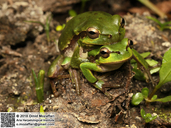|
Distribution and Habitat
Country distribution from AmphibiaWeb's database: Armenia, Azerbaijan, Belarus, Bulgaria, Georgia, Greece, Iran, Islamic Republic of, Latvia, Moldova, Republic of, Poland, Romania, Russian Federation, Serbia, Turkey, Ukraine
The range of Hyla orientalis almost completely circumnavigates the Black Sea (and possibly does) throughout Turkey, northwest through Bulgaria and eastern Romania and north through Ukraine, Poland and as far as Lithuania; to the east, it ranges across the Caucasus Range to the Caspian Sea and northern Iran (Stoeck et al 2008). Comments
This species was featured in news of the week October 10, 2022.
In 1986, the Chernobyl (or alternatively spelled ‘Chornobyl’) nuclear accident in northern Ukraine released unprecedented amounts of radioactive material into the environment. Within the Chernobyl Exclusion Zone, Burrac and Orizaola (2022) surveyed the Eastern Tree Frog (Hyla orientalis) and found increased melanism compared with frogs just outside the Exclusion Zone. It is known that the dark melanin-based pigments could protect fungi against ionizing radiation but a protective role in melanism for vertebrates remains debated because of potentially high physiological costs associated with melanism. Burrac and Orizaola found no physiological costs associated with the maintenance of dark skin coloration in terms of frog body condition or oxidative status. Furthermore no short-term changes in coloration were detected, indicating that high levels of ionizing radiation, likely at the time of the accident, may have been selected for darker coloration in Chernobyl tree frogs. (Written by Molly Womack)
This species was featured in news of the week August 28, 2023.
The Chernobyl nuclear power plant catastrophe occurred over 30 years ago and researchers are now gaining a better understanding of the long-term effects of nuclear exposure to wildlife. Recently, Car et al. (2023) surveyed populations of Hyla orientalis both within and outside of the Chernobyl Exclusion Zone to assess the population structure, genetic diversity, and individual gene expression. They found that frogs inside the exclusion zone had decreased body conditions, and smaller population sizes despite ongoing migration from low to high contaminated sites. Furthermore, populations within the exclusion zone had a unique transcriptome signature and more termination mutations in their energy metabolism pathways than those outside of the exclusion zone. While these results are correlative, they suggest either a relationship with radiation exposure and highlight the need for more research into the causal relationship of radiation exposure and long-term deleterious effects in wildlife. (Ann Chang)
References
Stoeck M, Dubey S, Kluetsch C, Litvinchuk SN, Scheidt U, Perrin N. (2008). "Mitochondrial and nuclear phylogeny of circum-Mediterranean tree frogs from the Hyla arborea group." Molecular Phylogenetics and Evolution, 49, 1019-1024. [link]
Originally submitted by: Michelle S. Koo (2022-10-09)
Edited by: Michelle S. Koo (2023-08-26)Species Account Citation: AmphibiaWeb 2023 Hyla orientalis: Eastern Tree Frog <https://amphibiaweb.org/species/7317> University of California, Berkeley, CA, USA. Accessed Nov 22, 2024.
Feedback or comments about this page.
Citation: AmphibiaWeb. 2024. <https://amphibiaweb.org> University of California, Berkeley, CA, USA. Accessed 22 Nov 2024.
AmphibiaWeb's policy on data use.
|





 Map of Life
Map of Life